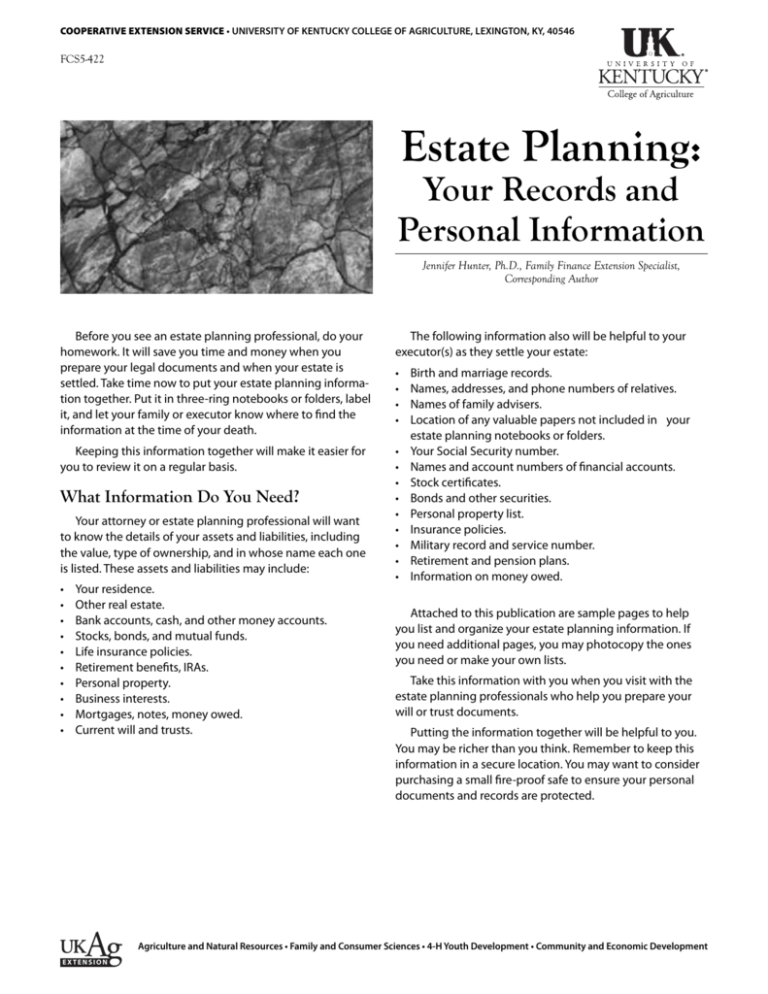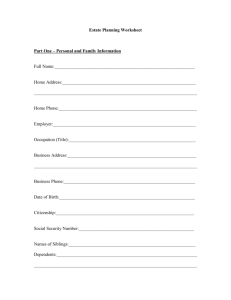FCS5-422: Estate Planning: Your Records and Personal Information
advertisement

COOPERATIVE EXTENSION SERVICE • UNIVERSITY OF KENTUCKY COLLEGE OF AGRICULTURE, LEXINGTON, KY, 40546 FCS5-422 Estate Planning: Your Records and Personal Information Jennifer Hunter, Ph.D., Family Finance Extension Specialist, Corresponding Author Before you see an estate planning professional, do your homework. It will save you time and money when you prepare your legal documents and when your estate is settled. Take time now to put your estate planning information together. Put it in three-ring notebooks or folders, label it, and let your family or executor know where to find the information at the time of your death. The following information also will be helpful to your executor(s) as they settle your estate: Keeping this information together will make it easier for you to review it on a regular basis. • • • • • • • • • What Information Do You Need? Your attorney or estate planning professional will want to know the details of your assets and liabilities, including the value, type of ownership, and in whose name each one is listed. These assets and liabilities may include: • • • • • • • • • • Your residence. Other real estate. Bank accounts, cash, and other money accounts. Stocks, bonds, and mutual funds. Life insurance policies. Retirement benefits, IRAs. Personal property. Business interests. Mortgages, notes, money owed. Current will and trusts. • • • • Birth and marriage records. Names, addresses, and phone numbers of relatives. Names of family advisers. Location of any valuable papers not included in your estate planning notebooks or folders. Your Social Security number. Names and account numbers of financial accounts. Stock certificates. Bonds and other securities. Personal property list. Insurance policies. Military record and service number. Retirement and pension plans. Information on money owed. Attached to this publication are sample pages to help you list and organize your estate planning information. If you need additional pages, you may photocopy the ones you need or make your own lists. Take this information with you when you visit with the estate planning professionals who help you prepare your will or trust documents. Putting the information together will be helpful to you. You may be richer than you think. Remember to keep this information in a secure location. You may want to consider purchasing a small fire-proof safe to ensure your personal documents and records are protected. Agriculture and Natural Resources • Family and Consumer Sciences • 4-H Youth Development • Community and Economic Development EXTENSION Personal Information List all members of your immediate family (you, your spouse, and children, including those who are married and/or living away from home). Name Address Date of Birth Where Birth Recorded Social Sec. No. Military Branch You Spouse Children Close Relatives or Friends List those who should be notified when serious emergencies occur. Name Address and Phone Number Family Advisers List advisers you depend on in your personal and business affairs. Type of Adviser Name Address and Phone Number Accountant Attorney Banker Broker Clergy Doctor(s) Dentist Financial Planner Insurance Agent(s) Other 2 Military No. Comments Location of Valuable Papers Being able to find valuable papers quickly is vital to you and your survivors. Under the Location column, clearly identify the specific desk and drawer, closet, safe deposit box, box, etc., where each valuable paper is kept. TYPE OF INFORMATION LOCATION Wills/Trusts and Instructions Your will/trust Spouse’s will/trust Copies of wills/trusts Burial, cremation, funeral directions Memorial society membership Special letters of instruction Power of attorney Health care power of attorney Personal Birth certificates Baptism certificates Marriage certificates Adoption certificates Divorce certificates Death certificates Naturalization papers Diplomas Passports Social Security cards Employment records Armed forces records Family health records Personal Property Checkbooks Savings passbooks and certificates Insurance (life, health, accident) Stock certificates Savings bonds Safe deposit box and key Income tax records Canceled checks and stubs Inventory of household goods Motor vehicle title(s) Registrations—motor vehicle, dog, etc. (continued on next page) 3 Location of Valuable Papers Being able to find valuable papers quickly is vital to you and your survivors. Under the Location column, clearly identify the specific desk and drawer, closet, safe deposit box, box, etc., where each valuable paper is kept. TYPE OF INFORMATION LOCATION Guarantees on appliances Credit card account information Real Estate Deed to your house Deed(s) to other real estate Records of property improvements Mortgage papers Mortgage payment receipts Insurance policies Banking Services Banks, savings and loan associations, credit unions, etc., provide many financial services for families. List the services you use. FINANCIAL FIRM’S NAME, ADDRESS IDENTIFICATION NUMBER Checking Accounts Savings Accounts Certificates of Deposit Money Market Certificates Trust Accounts Safe Deposit Box Other Services (include financial planners) 4 IN WHOSE NAME(S) Real Estate and Business Interests List real estate owned by your family and business interests. (Kind of Ownership refers to tenancy in common, joint ownership, or single ownership.) Kind ofProperty Location(address) Kind of Ownership Name(s) of Owner Date Purchase Acquired Price Stocks, Bonds, and Securities List any U.S. Savings Bonds, U.S. Treasury securities, government agency securities, corporate and govern- mental stock certificates, and other securities owned by you or an immediate family member. Name of Asset Serial Number Date Purchased Purchase Price Other Useful Information (name of owner, no. of shares, maturity date) Mutual Funds List each mutual fund and money market fund owned by you or a member of your immediate family. Company Name and Fund Type Identification Number Date Acquired Original Amount Other Useful Information (name of owner, no. of shares, maturity date) Other Personal Property List motor vehicles, boats, mobile home, and other items of value (jewelry, antiques, books, collections, royalties, patents, etc.) owned by you or a member of your immediate family. Name of Asset Date Acquired Purchase Price or Value 5 Other Useful Information (name of owner, where acquired, where stored) Property Insurance Owners of property carry insurance on different kinds of risks such as fire, wind, liability, theft, etc. In this section, inventory your insurance policies. Description of Property Insured Kind of Risk Insured Amount of Coverage Policy Number Name of Company Real Estate Motor Vehicles Other Property Personal Liability Other Life Insurance and Annuities List all life insurance policies and annuities carried on members of your immediate family. Indicate the kind of policy, such as term, whole life, endowment, family income, etc. If the owner of the policy is not the person insured, list both the owner and the insured. Person Insured Kind of Policy Policy Face Value Policy Number 6 Beneficiary Name of Insurance Company Health Insurance—Accident, Disability, Hospital Include primary health care insurer, major medical, other employer’s insurance, Medicare, long-term care insurance, and/ or individual policies on family members. Person(s) Insured Kind of Policy Amount of Coverage Policy Number Name of Group or Company Providing Insurance Social Security, Employment, and Retirement Information concerning these items is often needed in filing applications, checking records, settling estates, etc. SOCIAL SECURITY Name of Insured Social Security Number EMPLOYMENT RECORD Name of Family Member Employer’s Name Employment Date RETIREMENT, PENSION, OR PROFIT-SHARING PLAN Person in Plan Plan Name 7 Money Owed This list can help you to find out how much of your future income or other assets you have promised to others. It would be extremely valuable to those who handle your affairs during any serious illness you have or after your death. Person/Company Owed Address Size of Original Debt Terms of Payment This publication is based on material produced by the Cooperative Extension Service, Kansas State University, Manhattan, Kansas. Kentucky’s modification was prepared by Suzanne Badenhop, Ph.D., Emeritus Extension Specialist, Family and Consumer Sciences. This is the third publication in a nine-part series on estate planning. Other publications in the series cover: Getting Started (FCS5-420) Objectives (FCS5-421) Selecting Your Estate Planning Team (FCS5-423) Financial Planners (FCS5-424) Wills and Probate in Kentucky (FCS5-425) Trusts (FCS5-426) Federal and State Estate Taxes (FCS5-427) A Glossary of Terms (FCS5-428) Educational programs of the Kentucky Cooperative Extension Service serve all people regardless of race, color, age, sex, religion, disability, or national origin. Issued in furtherance of Cooperative Extension work, Acts of May 8 and June 30, 1914, in cooperation with the U.S. Department of Agriculture, M. Scott Smith, Director of Cooperative Extension, University of Kentucky College of Agriculture, Lexington, and Kentucky State University, Frankfort. Copyright © 2011 for materials developed by the University of Kentucky Cooperative Extension Service. This publication may be reproduced in portions or its entirety for educational or nonprofit purposes only. Permitted users shall give credit to the author(s) and include this copyright notice. Publications are also available on the World Wide Web at: http://www.ca.uky.edu. Issued: 5-2001








